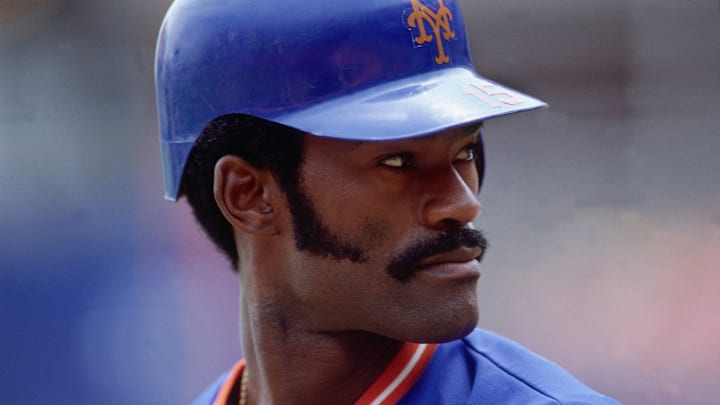George Foster arrived in New York on February 10, 1982, in a trade with the Cincinnati Reds. The New York Mets sent Alex Trevino, Greg Harris, and Jim Kern to Cincinnati for Foster and immediately signed him to a five year, $10 million contract. The fanbase was ecstatic. After the dark days of the post Tom Seaver trade, finally there was a reason to believe that the new owners, Nelson Doubleday and Fred Wilpon, were serious about putting a winning team on the field.
Jokes about how airplanes from LaGuardia airport would now be in danger if they flew too low while George Foster was at bat were common around Shea Stadium. However, this would turn out to be another case of how the best laid plans sometimes go astray.
Welcome to the New York Mets, Mr. George Foster
In 1982, George Foster was still considered to be one of the best hitters in the National League. He won the MVP in 1977 as well as becoming only the tenth player to hit 50 home runs in one season. Although his offense had begun to slack off some after this monster season, he was still one of the most feared hitters in baseball. Even at age 33, there was every reason to believe that with his bat in the lineup, better days were on their way.
Foster usually batted clean-up for the Mets, hitting between catcher John Stearns and first baseman David Kingman. Even with all the lineup protection this team could provide, Foster hit only 13 HRs with 70 RBI. This was a far cry from his eleven years in Cincinnati where he had averaged 32 HRs and 110 RBI. The Mets would finish in last place with a record of 65-97.
Things have got to get better. They can't get much worse.
The following year saw a rebound of sorts for George Foster. The Mets traded for Keith Hernandez and brought up young phenom Darryl Strawberry in mid-season. With this added protection in the lineup, Foster responded slugging 28 HRs and 90 RBI. Unfortunately, this personal improvement did not translate to success on the field. The Mets were still mired in last place. Their record of 68-94 showed only a minimum increase of success.
The 1984 season saw the dawning of a new age for the Mets. Davey Johnson was promoted from the minors to manage the team filled with many of his former players like Dwight Gooden. Foster, now 35 years old and acting as an elder statesman to this youth movement, responded with 24 HRs and 86 RBI. This time, the improvement was seen in the standings as the team responded with a record on 90-72, their most wins since their World Champion season of 1969.
Don't look back. Someone might be gaining on you.
George Foster’s playing time became more limited in 1985. The Mets, now a contender, had traded for superstar catcher Gary Carter in the offseason. With the middle of the lineup now consisting of Hernandez, Carter, and Strawberry, Foster was dropped lower in the order. His 21 HRs and 77 RBI contributed to the team record of 98-64 but his contributions to their success became fewer.
By 1986, even George Foster could see that the end was near. He began to play less as his hitting and outfield defense fell off while the Mets were looking to find more at bats for future MVP Kevin Mitchell. Foster caught flack in the press for remaining on the bench during a Mets/Reds bench clearing fight on July 21. Soon after, the Mets announced that Kevin Mitchell would be the everyday left fielder. Finally on August 7, the Mets released George Foster. He claimed that this move was racially motivated, but Mitchell was every bit a man of color as was Foster. He went on to sign with the White Sox but was released after a 15 day tryout, never to play another game in MLB.
New York Mets retrospective: George Foster trade from the Reds. Epilogue
I believe that most fans look at George Foster's time with the Mets as a bad memory. It's just another example of the same old Mets. When you look at the results, it is hard to argue with that point of view. While Foster certainly didn’t measure up to expectations, perhaps the fault is also shared by those who initiated those expectations. Remember, Foster had one year to go on his contract with the Reds and wanted a contract extension.
The Reds refused and facilitated the trade. What did they see that the Mets didn't see? Of course, Foster took the money. Who wouldn’t? But when you sign the biggest contract you are expected to deliver the biggest numbers. That one’s on Foster. But in 1982, Foster was five years removed from his MVP season with his statistics showing a slow but steady decline. The Mets and the press led us to believe that Foster would somehow find the fountain of youth and be a superstar again. That’s not only on them, but that’s on the fans for believing it.
Was the George Foster trade a good one? Probably not. But it did show that the new ownership was willing to spend money to build a winner so if it in some way lead to the trades for Hernandez and Carter and a world championship, maybe it’s OK. Draw your own conclusions. In the end I believe we are better off that the trade happened than not. It was a small step in the right direction.
